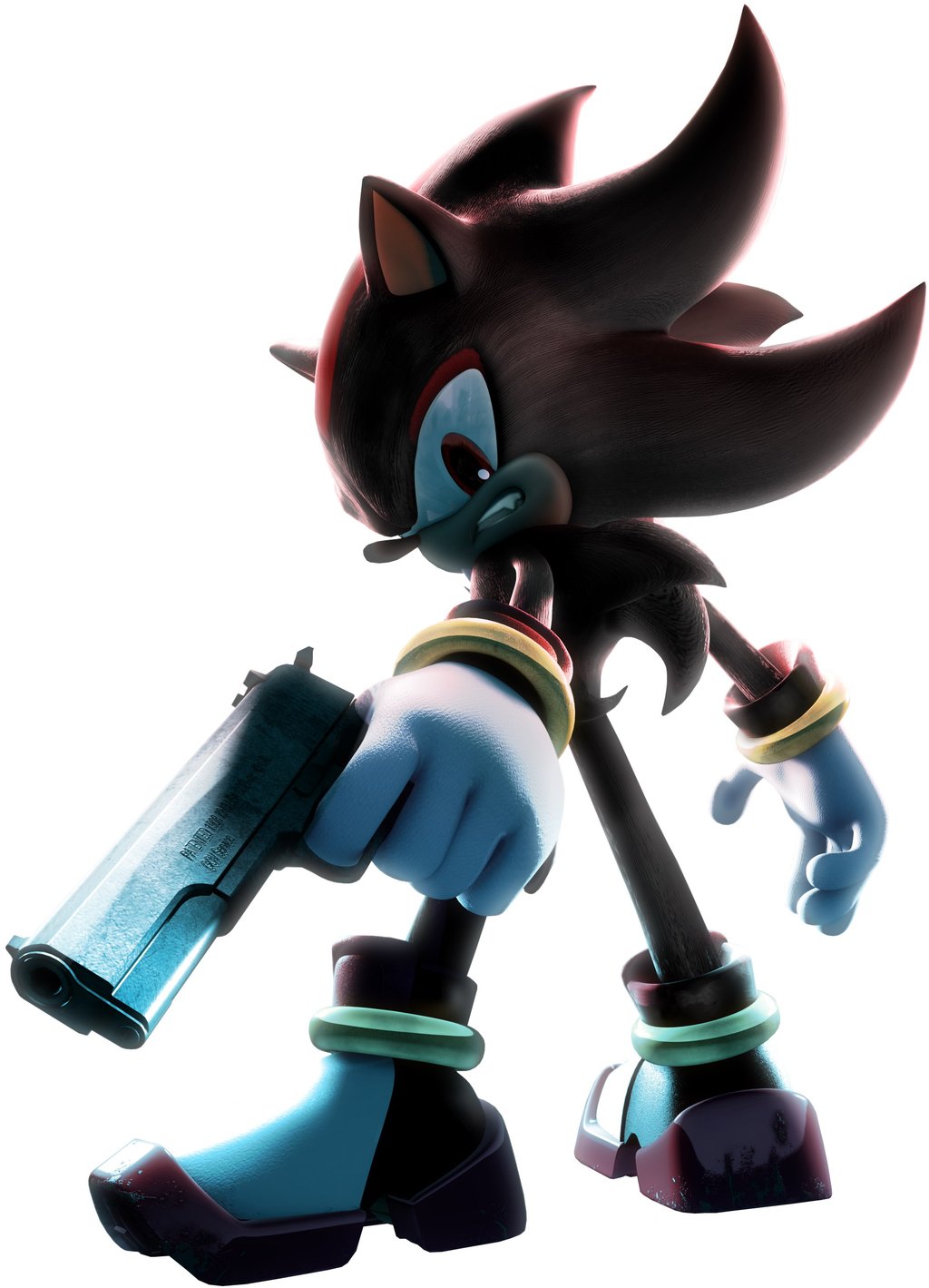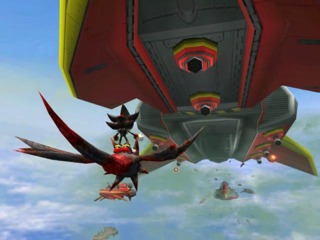Overview

Shadow the Hedgehog is a 3D sci-fi platformer developed the Sega Studios USA division of Sonic Team and published by Sega for the Xbox, PlayStation 2, and GameCube on November 15, 2005.
A spin-off of the Sonic the Hedgehog series that is intended for older audiences, Shadow the Hedgehog takes place after the events of Sonic Heroes and puts players in the role of the eponymous amnesiac antihero as he learns more about his backstory and becomes intertwined in a conflict between the alien race Black Arms (led by the mysterious Black Doom), the Guardian Units of Nation (alongside Sonic the Hedgehog and friends), and Dr. Eggman's robotic army.
Along with the traditional gameplay from that era of Sonic games, Shadow the Hedgehog features the ability to use weaponry (including guns for ranged combat and swords for melee combat) and driveable vehicles. The game's main draw is a branching storyline based on choices the player makes throughout the game. Depending on which objective is fulfilled throughout each level, the game can span in numerous paths (with 10 possible endings and an unlockable true ending).
Gameplay
Gameplay is usually divided into three different objectives: Hero, Dark, and Neutral. The Hero and Dark side objectives can involve shooting down members of a specific side or activating defense mechanisms. Hero, for example, may order Shadow to gun down the Black Arms aliens, while Dark may require Shadow to attack the GUN soldiers. The Neutral Side, when available in a mission, mostly requires Shadow to reach the end of the level to collect the Chaos Emeralds, emulating the original intent of Sonic games: to reach the level's end as quickly as possible.
 Shadow can use weapons, vehicles, and enemies to explore the levels.
Shadow can use weapons, vehicles, and enemies to explore the levels.Shadow has many different weapons and items to use in battle, ranging from street signs and swords, to pistols and alien weapons. He can also man vehicles and turrets when available, and has the power to use the Chaos Emeralds' Chaos abilities. Performing Heroic deeds like healing soldiers and attacking aliens fills the Hero gauge, which when full can be spent on Chaos Control, an extremely fast warp through a level. In contrast, the Dark gauge can be filled by attacking soldiers and causing destruction, which when full can be spent on Chaos Blast, a full-scale attack on every enemy on screen.
Levels
The game's path
Stage 1
Stage 2
- Digital Circuit (Dark)
- Glyphic Canyon (Normal)
- Lethal Highway (Hero)
Stage 3
- Cryptic Castle (Dark)
- Prison Island (Normal)
- Circus Park (Hero)
Stage 4
- Central City (Dark)
- The Doom (Semi-Dark)
- Sky Troops (Normal)
- Mad Matrix (Semi-Hero)
- Death Ruins (Hero)
Stage 5
- The ARK (Dark)
- Air Fleet (Semi-Dark)
- Iron Jungle (Normal)
- Space Gadget (Semi-Hero)
- Lost Impact (Hero)
Stage 6
- GUN Fortress (Dark)
- Black Comet (Semi-Dark)
- Lava Shelter (Normal)
- Cosmic Fall (Semi-Hero)
- Final Haunt (Hero)
Last Stage
- The Last Way (unlocked by reaching all ten normal endings of the game)
Companions
Throughout the game, Shadow can fulfill the objectives of guides that follow him. Dark objectives are usually given by Black Doom's "seeing eye" (known as the Doom's Eye). Additionally, most of these allies help with combat and, in the PS2 and GameCube versions, can be controlled by a second player. The only ones that cannot be controlled are the Doom's Eye, Dr. Eggman, and Charmy Bee.
- Sonic the Hedgehog (1-Normal, 2-Hero, 5-Semihero, 6-Hero)
- Rouge the Bat (2-Dark, 4-Hero, 6-Dark)
- Knuckles the Echidna (2-Normal, 4-Dark, 6-Semidark)
- E-123 Omega (5-Normal, 6-Normal)
- Miles "Tails" Prower (3-Hero, 5-Semidark)
- Maria (4-Semidark, 5-Hero)
- Amy Rose (3-Dark)
- Espio the Chameleon (4-Semihero)
- Vector the Crocodile (6-Semihero)
Credits
- Producer - Yuji Naka
- Director/Lead Game Designer - Takashi Iizuka
- Game Designer - Hirono Sato
- Game Designer - Asahiko Kikuchi
- Game Designer - Yu Ohmura
- Game Designer - Eitaro Toyoda
- Art Director - Kazuyuki Hoshino
- Field Art Director - Hiroshi Nishiyama
- Field Artist - Michikazu Tamamura
- Field Artist - Hiroshi Kanazawa
- Field Artist - Takahiro Kudo
- Artist - Daizo Kinoshita
- Artist - Soosa Kim
- Artist - Ai Ikeda
- Artist - Elena Macomber
- Artist - Brad Wagner
- Artist - Nobuhiko Honda
- Motion Designer - Atsushi Saito
- Event Scene Director - Shun Miyanaga
- Lead Programmer - Takeshi Sakakibara
- Senior Programmer - Mitsuru Takahashi
- Senior Programmer - Tomoyuki Naito
- Senior Programmer - Outa Sano
- Programmer - Masato Nakazawa
- Programmer - Satoru Takeshima
- Programmer - Motoyoshi Sato
- Programmer - Kazuyuki Okada
- CG Movie Producer - Keith Palmer
- Sound Director - Jun Senoue
- Development Support - Shiro Maekawa
- Development Support - Makato Hirata
- Executive Producer - Hisao Oguchi
Log in to comment